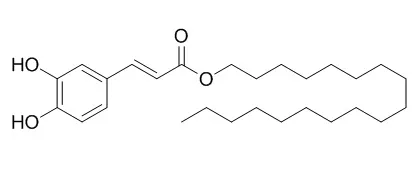| In vitro: |
| Fitoterapia. 2014 Mar;93:239-44. | | Alkaloids from Coptis chinensis root promote glucose uptake in C2C12 myotubes.[Pubmed: 24444890 ] | The root of Coptis chinensis Franch. (COCH) is regularly used for medicinal purposes, and has been prescribed alone or in combination with other traditional herbs for the treatment of diabetes.
METHODS AND RESULTS:
To investigate the effects of COCH on glucose utilization by skeletal muscles, we prepared an ethanol extract of COCH root (COCH-Et) partitioned with dichloromethane, n-butanol, and water and tested its effects on glucose uptake in differentiated C2C12 myotubes. We found that dichloromethane and n-butanol sub-fractions of COCH-Et promoted glucose uptake in differentiated C2C12 cells at 50 μg/mL. Further fractionation of these preparations by using column chromatography, analysis of their effects on glucose uptake and characterization using nuclear magnetic resonance, mass spectrometry, and thin layer chromatography helped identify two new alkaloids, 8,13-dioxocoptisine hydroxide (1) and coptisonine (2), together with eleven known compounds. These were isolated from the dichloromethane layer of COCH-Et. In particular, exposure of C2C12 cells to berberine (6) at 12.5 and 6.25 μg/mL for 24h resulted in significant promotion of glucose uptake. Coptisonine (2) and Octadecyl caffeate (9) also stimulated glucose uptake at 25 and 50 μg/mL.
CONCLUSIONS:
These findings indicate that active constituents of COCH root may help alleviate hyperglycemia in diabetes by promoting glucose uptake by skeletal muscles. | | J Agric Food Chem. 2013 Aug 28;61(34):8141-7. | | Resistance to the weevils Cylas puncticollis and Cylas brunneus conferred by sweetpotato root surface compounds.[Pubmed: 23906084] |
METHODS AND RESULTS:
Seven resistant varieties of sweetpotato were compared with three susceptible varieties in field trials and laboratory bioassays and showed that resistance was an active process rather than an escape mechanism, as field resistant varieties also had reduced root damage and oviposition compared with susceptible varieties in the laboratory. Liquid chromatography-mass spectrometry (LC-MS) of root surface and epidermal extracts showed significant variation in the concentration of hexadecyl, heptadecyl, octadecyl, and quinic acid esters of caffeic and coumaric acid, with higher concentrations correlated with resistance. All compounds were synthesized to enable their positive identification.
CONCLUSIONS:
Octadecyl coumarate and Octadecyl caffeate applied to the surface of susceptible varieties in laboratory bioassays reduced feeding and oviposition, as observed on roots of resistant varieties, and therefore are implicated in weevil resistance. Segregating populations from breeding programs can use these compounds to identify trait loci for resistance and enable the development of resistant varieties. |
|






 Cell. 2018 Jan 11;172(1-2):249-261.e12. doi: 10.1016/j.cell.2017.12.019.IF=36.216(2019)
Cell. 2018 Jan 11;172(1-2):249-261.e12. doi: 10.1016/j.cell.2017.12.019.IF=36.216(2019) Cell Metab. 2020 Mar 3;31(3):534-548.e5. doi: 10.1016/j.cmet.2020.01.002.IF=22.415(2019)
Cell Metab. 2020 Mar 3;31(3):534-548.e5. doi: 10.1016/j.cmet.2020.01.002.IF=22.415(2019) Mol Cell. 2017 Nov 16;68(4):673-685.e6. doi: 10.1016/j.molcel.2017.10.022.IF=14.548(2019)
Mol Cell. 2017 Nov 16;68(4):673-685.e6. doi: 10.1016/j.molcel.2017.10.022.IF=14.548(2019)